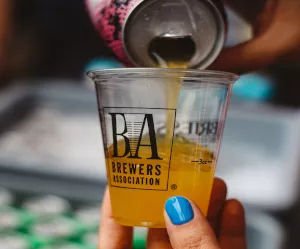In the dynamic landscape of craft beer, where tradition meets innovation, the Brewers Association recently delivered its annual state of the industry address, offering a comprehensive overview of the challenges and opportunities facing America’s small and independent breweries. Chief Economist Bart Watson aptly described the current environment as a “challenging landscape,” acknowledging both triumphs and tribulations during his address at the Craft Brewers Conference in Las Vegas, Nevada.
While craft beer production experienced a modest decline of 1%, the industry witnessed a nuanced pattern of growth and contraction across various segments. Taprooms and brewpubs faced declines of 2% and 4%, respectively, while regional breweries saw a modest uptick of 1%. Microbreweries, however, encountered a more significant setback with a 5% decrease. Despite these fluctuations, Watson highlighted a noteworthy statistic: 44% of breweries achieved growth, underscoring pockets of resilience within the sector.
Amidst a backdrop of stagnating growth, breweries grapple with mounting financial pressures as costs outpace price increases. Nevertheless, Watson emphasized the enduring consumer enthusiasm for craft beer, with an estimated $30 billion spent on small and independent brewers in the past year alone. This steadfast patronage underscores the intrinsic value and enjoyment consumers derive from craft brews.
To navigate these challenges, breweries are adopting multifaceted strategies aimed at bolstering operational efficiency and expanding market reach. Collaborations and partnerships offer avenues for achieving economies of scale, while innovative approaches to product distribution seek to tap into new consumer segments and occasions for consumption.
Moreover, there exists a vast reservoir of untapped potential, with an estimated 125 million Americans abstaining from craft beer consumption each month. Recognizing this latent market, breweries are exploring novel channels and occasions to engage consumers, fostering brand loyalty and expanding their customer base.
 Amidst the flux, craft breweries are urged to embrace diversification, capitalizing on ancillary revenue streams to supplement traditional beer production. From hosting immersive events to forging strategic collaborations, breweries can leverage existing assets to create unique and compelling experiences for consumers.
Amidst the flux, craft breweries are urged to embrace diversification, capitalizing on ancillary revenue streams to supplement traditional beer production. From hosting immersive events to forging strategic collaborations, breweries can leverage existing assets to create unique and compelling experiences for consumers.
Moreover, a keen focus on consumer trends enables breweries to stay ahead of the curve, driving product innovation and adaptation. By aligning with evolving preferences, such as the resurgence of lagers and the emergence of non-alcoholic alternatives, breweries can maintain relevance and appeal in a rapidly evolving market.
In parallel, a renewed emphasis on gross margins underscores the importance of financial sustainability. By optimizing cost inputs and streamlining operations, breweries can safeguard profitability amidst fluctuating market dynamics, ensuring long-term viability and resilience.
As the craft beer industry navigates this period of uncertainty, adaptability and innovation emerge as guiding principles for success. By embracing change and fostering a culture of creativity, breweries can carve out a resilient path forward, sustaining the spirit of craft beer for generations to come.





